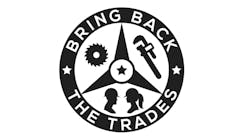Latest from Training
Sponsored
The ongoing skilled labor shortage is a major problem for the contracting industry that requires no introduction. As has been covered extensively in this publication, good help is hard to find, and there is only so much we can do to influence that reality in the short term. Meanwhile, projects still need to be completed within increasingly tight timelines, leaving owners and managers everywhere asking themselves, “How do I still get the job done with the resources I have, using my skilled workforce most efficiently without sacrificing quality?”
While you may not be able to fill the skilled labor gap in the market right now, the good news is there are steps you can take to help your workforce be more efficient. The even better news is you don’t have to do it alone—you likely already have partners in place that can help.
When it comes to reinforcing the health of the contracting industry, we’re all in this together—contractors, manufacturers, distributors and designers. That’s a key reason why we should be working together to keep projects moving and job quality high as we work through the staffing-related struggles our industry faces.
Reimagine Team Training
One of the best ways to ensure you’re making the most of your skilled workers is to implement training programs that not only educate new team members, but keep your seasoned veterans up-to-date on tools, trends and technologies that can help improve the speed and accuracy of contracting jobs. Material and component suppliers can be of help here, as they not only develop the products that your teams use but may also sit on code bodies and committees that provide them a view into what’s coming next. These professionals can identify opportunities for how your team can stay ahead of emerging trends and may even be able to directly provide the education necessary to help you win in the field.
Manufacturing representatives are often tapped for consultation not only by design engineers and decision makers, but installers, supervisors, “means and method” managers and others who are looking for innovative ways to accomplish more with fewer resources. Suppliers can help with training in a variety of ways that can even be eligible for continuing education units (CEUs) or professional development hours (PDHs), including:
Training in the field
Certain building and construction manufacturers are available and willing to visit job sites to provide hands-on training for tradespeople in the field, offering insights in safety meetings, demonstrations of new applications and materials and best practices. These professionals often have a valuable perspective on how to best get a job done, because they have the benefit of working with many contractors across a broad geography that deal with a myriad of challenges. This enables trainers to then bring those learnings and fresh perspectives to the job site.
Training at a supplier’s facility
Effective training can also be delivered at the manufacturer’s facility in a controlled environment to showcase how contractors can get the most from the products they use while maximizing the quality of each finished job.
Training online
A third option is training through online courses provided via a learning management system (LMS) like BlueVolt. Manufacturers like nVent CADDY partner with LMS providers to create training modules according to established specifications, teaching installers how to avoid pitfalls and employ the most efficient techniques to get the job done. These modules often feature interactive content such as animations or 3D renderings, as well as embedded videos with “how-to” information included. Allowing appropriate time for your teams to freshen up on skills or explore content that may help them develop a skill is essential.
Make Better Use of Products and Processes
There are many products available to contractors that are designed specifically to cut down on required labor on the job site. For example, nVent CADDY developed a wide array of products designed by electricians for electricians to save time without jeopardizing the quality of the job. These products aren’t developed in a vacuum; they come from manufacturing team members working directly with contractors to find out what challenges they are experiencing that may slow the process. Based on conversations, product development teams build products designed to address evolving market needs.
Prefabricated products are often developed through processes such as these. A prefabricated solution is a great starting point for addressing not only the labor shortage, but the accelerating timelines, more competitive bids and stringent safety requirements in the industry today. Prefabrication allows contractors to trade precious on-site time for a more flexible off-site environment that can accommodate more time spent on design, setup and any possible pre-installation assemblies That way, you can centralize assembly and quality control when you are short on specialists or have short on-site schedules.
Choosing trusted brands that develop products for real-world applications is crucial. Manufacturers can aid in helping workers understand installation of specific products by providing 3D images, install sheets and other job aids that can be easily referenced via a mobile device in the field. Ask your supplier for resources that cover product use and processes in a manner that even the newest employee can understand.
Build Advocates
A common complaint among contracting firm leaders is that they can’t find well-suited workers and if they do, those employees tend to move on rather quickly. In this industry, you may not have incentives such as the availability to work from home that other businesses are offering to younger employees, so you need to be creative and identify other ways to retain top talent.
Workforce development isn’t all about empowerment through training and use of time-saving products. It’s also about getting employees plugged into a team—helping them feel like they are not just a cog in a machine but someone whose opinions and contributions matter to the success of the organization.
If employees are motivated, they feel like they are developing professionally and feel a sense of loyalty to the organization. We like to call these employees “advocates” as many of our employees are not only proud of their individual work, but proud to be a part of our team at nVent. They are our champions and in turn, we work to provide them opportunities to grow. Find ways to encourage and value their input, reward them appropriately and always tie what they’re doing back to business outcomes. The Millennial generation is known to especially want insights into how they are making a difference. Providing encouragement based on an idea for improvement is more powerful for retention than branded clothing or coffee mugs.
Think through what tools they have to get the job done or to grow professionally. Are there technologies or cutting-edge solutions that could make life easier for employees to help them feel like they’re a part of a forward movement? Don’t be afraid to embrace what's new, and don't resist change. That doesn’t mean you have to blindly adopt new technologies, but you should investigate how they might streamline your operations and or reinforce connections between engineers in your office and workers in the field.
Whatever you do to improve retention, promote it to attract new talent. If you're going to subsidize professional development or provide advanced training, make it clear in your recruiting language. The same goes whether you’re adopting new technology or working in new market verticals: Showcase why working at your organization is different and better, especially when the talent pool is shallow. And for your current stars, make it clear what opportunities can come their way if they stick with your team. Keep lines of communication open with your suppliers, no matter what—they may have ideas about how to make life easier and jobs more attractive for your existing employees.
When it comes to dealing with the skilled labor shortage, there’s no magic bullet to solve the problem. Industry paradigms are changing, and part of workforce development is being willing to evolve your approach to stay competitive. Make a lean, mean team by deploying the tools and techniques available to get more done more efficiently, by filling knowledge gaps through training and by committing yourself to being flexible through it all.
Rick Lees has been working at nVent CADDY as a senior technical support specialist and in a customer service role for more than 40 years, leading training efforts for many of those years.


